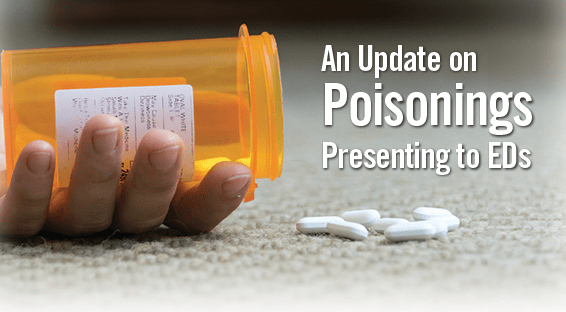In the United States, deaths from drug overdose have become a leading cause of injury-related mortalities. According to current estimates, drug misuse and abuse causes about 2.5 million visits to the ED. “Drug-related deaths now exceed motor vehicle accidents as the leading cause of accidental death in the U.S.,” says Richard C. Dart, MD, PhD. “This is an important issue for EDs because they are typically the first to encounter these cases.”
Despite being familiar with managing patients suspected of being poisoned, emergency physicians are continually challenged by the emergence of new types of poisoning. “Every year, emergency physicians encounter a new wave of poisoning agents that range from household products to drugs that are intended for recreational use,” Dr. Dart says. “Each newly identified poisoning agent may require a new approach to diagnose and manage.”
Examining Recent Trends
The National Poison Data System (NPDS) collects information from poison centers throughout the U.S. in order to recognize emerging poisonous hazards early. “This system can provide real-time advice while collecting data on a variety of poisonings, including those that may be new or unfamiliar to emergency physicians,” Dr. Dart says. Considering the challenges that come with managing new types of poisonings, the NPDS can play an integral role in helping EDs respond to dangerous substances.
Dr. Dart and colleagues had a study published in Annals of Emergency Medicine that summarized data from U.S. poison centers about new emerging chemicals and drugs that ED personnel may confront. Specifically, the research used 2012 data to explore trends in poisonings involving opioids, laundry detergents, bath salts, synthetic cannabinoids (eg, Spice), and energy drinks.
According to the results, poison centers across the country recorded 2.2 million human poison exposures in 2012, most of which involved patients contacting a poison center. Most of these cases are managed without the need for an ED visit. Emergency facilities were more likely to be involved in the management of poisonings as patient age increased. More than 51% of teenagers and nearly 38% of adults were treated for poisonings at healthcare facilities in 2012. Overall, the annual number of human exposure cases has leveled off in recent years, but more serious exposure cases requiring the involvement of EDs are continuing to rise.
Assessing Specific Agents
“The majority of poisonings ending in death in 2012 were primarily linked to misuse of opioids, but the NPDS also recorded mortalities from cardiovascular drugs and antidepressants,” Dr. Dart says. In addition, data show that the total number of prescription opioid exposures by children more than doubled between 2002 and 2012.
A new and unexpected source of poisonings among children has been found with single-use laundry detergent pods and liquid laundry detergents (Figure 1). “The adverse effects of poisoning with these agents are generally not life-threatening, but it’s important for ED personnel to be aware that they may cause poisoning cases, typically in children,” says Dr. Dart. ED physicians should consider laundry packet exposures more dangerous than open-container liquid exposures. Standard irrigation and follow-up are indicated for irritation of the eyes and mucous membranes, and typical airway management can help maintain the airway. Patients usually need a 2- or 3-hour observation period but can then be discharged if symptoms resolve.
Designed drugs like bath salts, which are a type of amphetamine, and synthetic marijuana also continue to poison users severely enough to require emergency medical care (Figure 2). The initial management of bath salt toxicity and synthetic marijuana is similar to that of other causes of agitated delirium. “However, patients with clinical effects from these agents should be observed closely because new structural versions are continually being created,” Dr. Dart says.
Regarding energy drinks, NPDS data show that children younger than 6 accounted for about half of reported poisoning exposures in 2012. National education efforts are being made to raise awareness of the risks of consuming energy drinks, and this appears to have helped reduce poison center reports of these poisonings.
Continued Vigilance Needed
Dr. Dart says that it is important to report suspected poisoning cases to poison control centers, especially if cases appear to be out of the ordinary. “Since EDs are typically the first to see new types of poisonings, it’s critical that emergency personnel call their poison control centers to report these events,” he says. “Reporting these poisonings can enable EDs to get help with managing patients and enable the information to be recorded in the NPDS. This will further our efforts to identify new emergency challenges with poisonings and reduce the burden on EDs to manage these events.”



 Janine Anthes
Janine Anthes